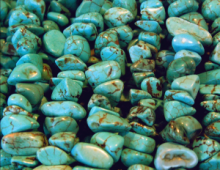Article
In many traditional cultures, turquoise has been valued for its color, which evokes both the sky and water. Because of the significance of the sky, which facilitates the passage of the sun and the coming of rain, turquoise is often referred to as “the sky stone.” Turquoise is associated with life, health, fortune, and blessings. Turquoise can be found in medicine pouches, incorporated into Zuni fetishes, carved into beads, and set as larger stones in traditional Navajo and Pueblo silver work, although it wasn’t until the late 19th century that turquoise was associated with silver jewelry, when Atsidi Sani, a Navajo silversmith, began incorporating turquoise stones into the Spanish-style silversmithing he had learned as an apprentice. Silver and turquoise jewelry was popularized by the burgeoning tourist trade in the Southwest, and nearby Pueblo people, Hopi and Zuni, also began making turquoise jewelry.
"Turquoise beads at the Tucson Rock and Gem Show, February 3, 2007" by cobalt123 is licensed under CC BY-SA.
Manuscripts
A01 The Blessing Way (01-07) p. 13
A01 The Blessing Way (01-07) p. 14
A01 The Blessing Way (01-07) p. 15
A01 The Blessing Way (01-07) p. 24
A01 The Blessing Way (01-07) p. 35
A01 The Blessing Way (01-07) p. 66
A01 The Blessing Way (01-07) p. 83
References
Adair, John
1944 Navajo and Pueblo Silversmiths. Civilzation of the American Indian Series. Norman:
University of Oklahoma Press.
Bennett, Edna Mau
1966 Turquoise and the Indian. Denver: Sage Books.
Keoke, Emory Dean, and Kay Marie Porterfield
2001 Turquoise and Silver Jewelry. Encyclopedia of American Indian Contributions to the
World: 15,000 Years of Inventions and Innovations. Facts On File, Inc., New York.
Lynch, Patricia Ann
2004 First Man and First Woman. Native American Mythology, Mythology A to Z. Facts On
File, Inc., New York.
O'Bryan, Aileen
1956 The Diné: Origin Myths of the Navaho Indians. Washington, D.C.: U.S. Government
Printing Office.
Witherspoon, Gary
1975 Navajo Kinship and Marriage. Chicago: University of Chicago.

